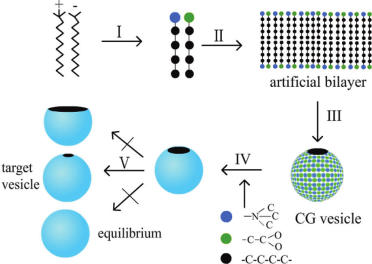Researchers at Shandong University and Lanzhou Institute of Chemical Physics (LICP), Chinese Academy of Sciences (CAS), have employed molecular dynamics to mimic the smallest vesicles formed in catanionic surfactant mixtures with a cationic quaternary ammonium group and an anionic carboxylate group but with various alkyl chain lengths.
 |
|
Steps for the simulation of the catanionic vesicles with minimum size. The coarse-grained (CG) vesicle model is replaced with an atomic artificial model in step IV, prior to the final simulation step. |
The cross sections of catanionic vesicles demonstrate that in some of the bilayers, the vesicles adopt multicurvature instead of identical curvature, especially for rigid bilayer systems. Presumably, multicurvature bending is the optimal organization for amphiphilic molecules residing in a curved bilayer, when bilayer curvature deviates far away from the spontaneous curvature. Comprehensive understanding of the multicurvature bilayer will enrich membrane theory and have great significance for further studies of surfactant self-assembly in solution. The effective measurement of catanionic bilayers also shows that molecular dynamics is a powerful tool to accurately characterize the mechanical properties of bilayers, which are crucial for understanding the phase behavior of bilayer systems and could contribute to our understanding of ion transport through bilayer membranes.
The work has received support from the National Natural Science Foundation of China, National Program on Key Basic Research Project of China (973 Program) and Natural Science Foundation of Shandong province.
The findings have been published in Langmuir(Langmuir2012, 28, 5927?5933) .

